Diagram Based Questions: The Human Eye and the Colourful World | Science Class 10 PDF Download
Q1: Answer the following questions based on the diagram given below:
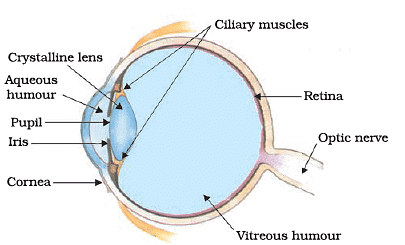
(i) Identify the parts labeled A, B, and C in the diagram of the human eye.
(ii) Explain how the cornea and lens work together to focus light on the retina.
(iii) What is the function of the retina in the human eye?
(iv) What role does the iris play in the eye's functioning?
(v) Explain the difference between nearsightedness and farsightedness, and how corrective lenses help in each case.
Ans:(i) A represents the cornea, B is the lens, and C denotes the retina.
(ii) The cornea and lens refract or bend incoming light rays. The cornea does most of the bending, while the lens fine-tunes the focus. Together, they ensure that the light converges on the retina, forming a clear image.
(iii) The retina contains light-sensitive cells called photoreceptors (rods and cones) that detect light and convert it into electrical signals. These signals are then sent to the brain via the optic nerve, allowing us to perceive images.
(iv) The iris controls the size of the pupil. In bright light, the iris contracts, making the pupil smaller to limit the amount of light entering the eye. In dim light, the iris expands, making the pupil larger to allow more light in for better vision.
(v) Nearsightedness (myopia) occurs when the image focuses in front of the retina, making distant objects appear blurry. Farsightedness (hyperopia) happens when the image focuses behind the retina, making close objects unclear. Corrective lenses for myopia are concave (diverging) to move the image back to the retina, while for hyperopia, they are convex (converging) to bring the image forward to the retina, thus improving vision.
Q2: Answer the following questions based on the diagram given below: 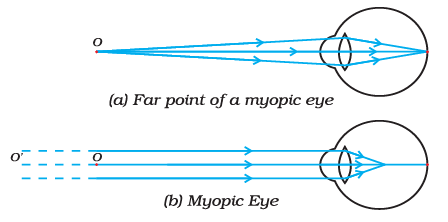
(i) What is myopia, and how does it affect the vision of a person?
(ii) Explain the role of the eyeball's shape in causing myopia.
(iii) Describe how a concave lens can help correct myopia.
(iv) What are the common symptoms of myopia, and how can one identify if they have this condition?
(v) Explain the difference between myopia and hyperopia (farsightedness).
Ans:(i) Myopia, commonly known as nearsightedness, is an eye condition where a person can see nearby objects clearly but has difficulty seeing distant objects. This happens because the image formed by the lens in a myopic eye falls in front of the retina instead of directly on it.
(ii) Myopia is often caused by an elongated eyeball. In myopic individuals, the eyeball is longer from front to back, which causes light rays to converge in front of the retina, making distant objects appear blurry.
(iii) A concave lens is used to correct myopia because it diverges incoming light rays before they enter the eye. This allows the light to focus properly on the retina, enabling a myopic person to see distant objects clearly.
(iv) Common symptoms of myopia include squinting to see distant objects clearly, frequent headaches, and difficulty reading the chalkboard or watching TV from a distance. An eye check-up by an optometrist can confirm if someone has myopia.
(v) Myopia and hyperopia are both refractive eye conditions, but they affect vision differently. Myopia, or nearsightedness, allows clear vision for nearby objects but causes blurriness for distant ones. In contrast, hyperopia, or farsightedness, causes difficulty in seeing nearby objects clearly but clear vision for distant objects because the light focuses behind the retina.
Q3: Answer the following questions based on the diagram given below:
(i) What is a hypermetropic eye?
(ii) Explain why a hypermetropic eye has difficulty seeing nearby objects.
(iii) How can someone with a hypermetropic eye correct their vision?
(iv) What is the difference between a hypermetropic eye and a normal eye?
(v) Can hypermetropia develop at any age, or is it present from birth?
Ans:(i) A hypermetropic eye is an eye that has difficulty focusing on nearby objects due to the light rays entering the eye converging behind the retina instead of directly on it. This condition is also known as farsightedness.
(ii) A hypermetropic eye has a shorter-than-normal eyeball, which causes light rays to focus behind the retina instead of on it. This means that when a person with hypermetropia tries to see something up close, the image is formed behind the retina, making it appear blurry.
(iii) Hypermetropia can be corrected using converging lenses, also known as convex lenses. These lenses help to converge the incoming light rays so that they focus properly on the retina, allowing the person to see nearby objects clearly.
(iv) The main difference between a hypermetropic eye and a normal eye is the shape of the eyeball. In a normal eye, the eyeball is typically longer, allowing light rays to focus directly on the retina. In a hypermetropic eye, the eyeball is shorter, causing light rays to focus behind the retina.
(v) Hypermetropia can be present from birth (congenital hypermetropia), but it can also develop later in life. Some individuals may not notice their hypermetropic condition until they reach their 40s or 50s when the natural aging process of the eye, known as presbyopia, causes difficulties with near vision.
Q4: Answer the following questions based on the diagram given below: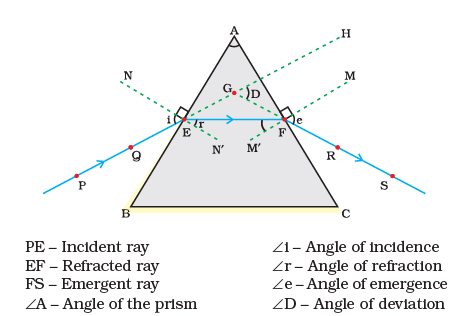
(i) What is the purpose of conducting the experiment with a triangular glass prism?
(ii) What happens to a ray of light when it enters the prism from air at an angle?
(iii) Why does the ray of light bend when it enters the prism?
(iv) Describe what happens when the refracted ray exits the other side of the prism.
(v) What is the main conclusion we can draw from this experiment about the behavior of light in a triangular glass prism?
Ans:(i) The purpose of this experiment is to observe and understand how light behaves when it passes through a triangular glass prism, including how it bends or refracts.
(ii) When a ray of light enters the prism from air at an angle, it undergoes refraction, meaning it changes direction and bends towards the base of the prism.
(iii) The ray of light bends because it slows down as it enters the denser medium of the glass prism. This change in speed causes the light to change its direction or refract.
(iv) When the refracted ray exits the other side of the prism and enters the air again, it bends away from the base of the prism and continues its path. This bending is known as refraction once more.
(v) The main conclusion from this experiment is that light undergoes two refractions as it passes through a triangular glass prism. It bends towards the base when entering the prism and away from the base when exiting, demonstrating the phenomenon of refraction.
Q5: Answer the following questions based on the diagram given below:
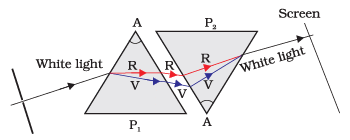
(i) What is the purpose of the experiment involving the recombination of the spectrum of white light?
(ii) What is the name of the device used to split white light into its constituent colors?
(iii) What happens to white light when it passes through a prism?
(iv) How can the spectrum of colors be recombined to form white light again?
(v) What is the significance of this experiment in understanding the nature of light?
Ans: (i) The purpose of the experiment is to show how white light can be split into its constituent colors (spectrum) and then recombined to form white light again.
(ii) The device used is called a prism.
(iii) When white light passes through a prism, it is refracted and separated into a spectrum of colors due to the different wavelengths of light bending by different amounts.
(iv) The spectrum of colors can be recombined by passing each color through another identical prism in the reverse order. When the colors exit the second prism, they overlap and combine to form white light.
(v) This experiment helps us understand that white light is composed of various colors with different wavelengths. It demonstrates the phenomenon of dispersion and the ability to recombine colors to recreate white light. This experiment laid the foundation for our understanding of the nature of light and the electromagnetic spectrum.
Q6: A narrow PQ of white light is passing through a glass prism ABC as shown in the diagram. Trace it on your answer sheet and show the path of the emergent beam as observed on the screen DE. (i) Write the name and cause of the phenomenon observed.
(i) Write the name and cause of the phenomenon observed.
(ii) Where else in nature is this phenomenon observed?
(iii) Based on this observation, state the conclusion which can be drawn about the constituents of white light.
Ans:
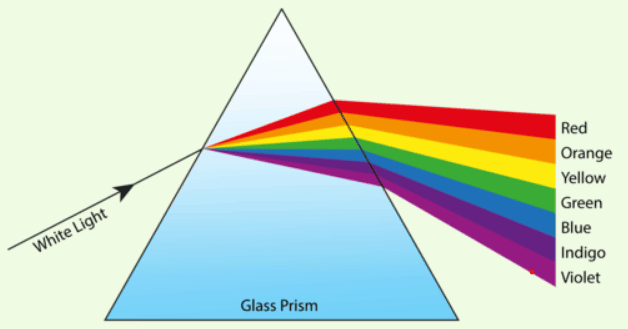
(i) The phenomenon of the splitting up of the white light into its constituents colours is called dispersion of light. Dispersion of light is caused due to, different constituents colours of light after different refractive indices to the material of the prism.
(ii) The formation of rainbow is caused by the dispersion of the white sunlight into its constituent colours.
(iii) Based on the dispersion of white light into its constituents colours, we can conclude that
(a) The white light consists of seven colours.
(b) The violet light Millers maximum deviations and the red light suffers minimum deviation.
Q7: Complete the path of white light when it passes through two identical prisms placed as shown with explanation for phenomenon. Ans: Newton was the first to use a glass prism to obtain the spectrum of a white light. He then placed a second identical prism in an inverted position with respect to the first prism. This allowed all the colours of the white light to pass through the second prism combining to form a white light emerging from the other side of the second prism. This made him believe that white light was composed of different colours.
Ans: Newton was the first to use a glass prism to obtain the spectrum of a white light. He then placed a second identical prism in an inverted position with respect to the first prism. This allowed all the colours of the white light to pass through the second prism combining to form a white light emerging from the other side of the second prism. This made him believe that white light was composed of different colours.

|
80 videos|569 docs|80 tests
|
FAQs on Diagram Based Questions: The Human Eye and the Colourful World - Science Class 10
| 1. How does the human eye work to perceive color? |  |
| 2. What are the three primary colors of light that the human eye can see? |  |
| 3. How does light interact with objects to produce different colors? |  |
| 4. Why do we see a rainbow when light passes through a prism? |  |
| 5. How do our eyes adjust to different lighting conditions to perceive colors accurately? |  |
















